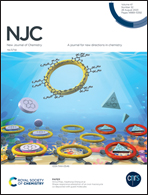The effect of substituents on the aggregation-induced emission of 9,10-phenanthraquinone-hydrazones†
Abstract
Organic luminophores, particularly π-conjugated systems, have become crucial in modern optoelectronic devices that utilise luminescence as an output signal, requiring aggregate or solid-states, such as nanoparticles, thin films, or crystals. Herein, we report the one-step synthesis of six hydrazone derivatives using condensation reactions between 9,10-phenanthrenedione and different aromatic hydrazines, comprising electron-donating/electron-withdrawing groups and a quinoline moiety. The introduction of a conjugated π-system leads to complete co-planarization of molecules resulting in large bathochromic shifts in their absorption profile, the maximum red-shifts ever observed for the hydrazones. These hydrazones are weakly fluorescent in dilute acetonitrile solutions. However, they exhibit enhanced emissions of up to 300-fold in aggregated states. Dynamic light scattering (DLS) and scanning electron microscopy (SEM) studies support nanoaggregate formation. All the compounds exhibit red to NIR emissions in their crystalline state with as high as 75% quantum efficiency.



 Please wait while we load your content...
Please wait while we load your content...